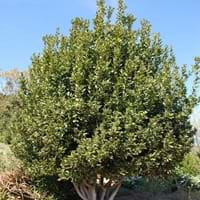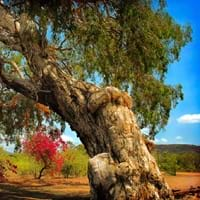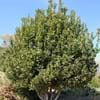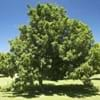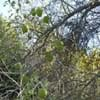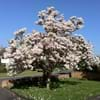Life Span
Perennial
Annual
Origin
Mediterranean
Southeastern Asia, Australia
Types
California bay leaf, Indian bay leaf or malabathrum, Indonesian bay leaf
Not Available
Habitat
Forest edges, Hillside
Warm and moist climatic conditions
USDA Hardiness Zone
8-11
9-15
Sunset Zone
5, 6, 7, 8, 9, 12, 13, 14, 15, 16, 17, 18, 19, 20, 21, 22, 23, 24
H1, H2, 9, 12, 13, 15, 16, 17, 20, 21, 22, 23, 24
Habit
Pyramidal
Upright/Erect
Flower Color
Yellow green
Light Yellow, Light Pink, Ivory
Flower Color Modifier
Bicolor
Bicolor
Fruit Color
Black
Sandy Brown
Leaf Color in Spring
Dark Green
Green, Dark Green
Leaf Color in Summer
Dark Green
Dark Green
Leaf Color in Fall
Dark Green
Dark Green
Leaf Color in Winter
Dark Green
Dark Green, Plum
Leaf Shape
Linear
Elliptic
Plant Season
Spring, Summer, Fall, Winter
Spring, Summer, Fall, Winter
Sunlight
Full Sun, Partial Sun
Full Sun, Partial Sun
Type of Soil
Clay, Loam, Sand
Clay, Loam, Sand
The pH of Soil
Acidic, Neutral, Alkaline
Acidic, Neutral, Alkaline
Soil Drainage
Well drained
Average
Bloom Time
Spring
Late Summer, Early Fall, Fall, Late Fall
Tolerances
Drought
Wet Site, Pollution, Drought, Soil Compaction
Where to Plant?
Ground
Ground
How to Plant?
Seedlings, Stem Planting
Seedlings
Plant Maintenance
Medium
Medium
Watering Requirements
Requires regular watering
Get enough water whenever the soil is dry
In Summer
Lots of watering
Lots of watering
In Spring
Moderate
Moderate
In Winter
Average Water
Average Water
Soil pH
Acidic, Neutral, Alkaline
Acidic, Neutral, Alkaline
Soil Type
Clay, Loam, Sand
Clay, Loam, Sand
Soil Drainage Capacity
Well drained
Average
Sun Exposure
Full Sun, Partial Sun
Full Sun, Partial Sun
Pruning
Prune in summer, Prune in the late winter or spring, Remove damaged leaves, Remove shoots
Remove damaged leaves, Remove dead branches, Remove dead leaves
Fertilizers
All-Purpose Liquid Fertilizer
All-Purpose Liquid Fertilizer
Pests and Diseases
Red blotch
Red blotch
Plant Tolerance
Drought
Drought
Flowers
Insignificant
Showy
Flower Petal Number
Single
Single
Fragrant Flower
Not Available
Yes
Fragrant Fruit
Not Available
No
Fragrant Leaf
Yes
Not Available
Fragrant Bark/Stem
No
Not Available
Foliage Texture
Medium
Fine
Foliage Sheen
Matte
Matte
Attracts
Birds
Birds, Hummingbirds
Allergy
Asthma
Not Available
Aesthetic Uses
Not Used For Aesthetic Purpose
Showy Purposes
Beauty Benefits
Not Available
Not Available
Environmental Uses
Air purification
Air purification
Medicinal Uses
anti-allergy, Arthritis, Bronchitis, Headache, Muscle Pain, Pain killer
Antibiotic, Cough, Headache, hemorrhoids, Respiratory Disorders, Rheumatism
Part of Plant Used
Fruits, Leaves
Bark, Flowers, Leaves, Wood
Other Uses
Cosmetics, Oil is used for aromatherapy, Oil is used in perfume, soaps, creams, etc., Used As Food
Used as essential oil
Used As Indoor Plant
No
No
Used As Outdoor Plant
Yes
Yes
Garden Design
Container, Feature Plant, Foundation, Hedges, Herb / Vegetable, Mixed Border, Topiary / Bonsai / Espalier
Shade Trees, Street Trees, Tropical
Botanical Name
LAURUS nobilis
MELALEUCA quinquenervia
Common Name
Bay Laurel, Sweet Bay
Cajeput Tree, Paperbark Tree, Punk Tree
In Hindi
bay laurel
Paperbark tree
In German
Lorbeer
Paperbark tree
In French
laurier
Paperbark tree
In Spanish
laurel
Paperbark tree
In Greek
δάφνη
Paperbark tree
In Portuguese
louro
Paperbark tree
In Polish
wawrzynu
Paperbark tree
In Latin
sinus laurus
Paperbark tree
Phylum
Not Available
Magnoliophyta
Class
Not Available
Magnoliopsida
Family
Lauraceae
Myrtaceae
Clade
Angiosperms, Magnoliids
Angiosperms, Eudicots, Rosids
Tribe
Not Available
Not Available
Subfamily
Not Available
Not Available
Number of Species
Not Available
Season and Care of Bay Laurel and Paperbark Tree
Season and care of Bay Laurel and Paperbark Tree is important to know. While considering everything about Bay Laurel and Paperbark Tree Care, growing season is an essential factor. Bay Laurel season is Spring, Summer, Fall and Winter and Paperbark Tree season is Spring, Summer, Fall and Winter. The type of soil for Bay Laurel is Clay, Loam, Sand and for Paperbark Tree is Clay, Loam, Sand while the PH of soil for Bay Laurel is Acidic, Neutral, Alkaline and for Paperbark Tree is Acidic, Neutral, Alkaline.
Bay Laurel and Paperbark Tree Physical Information
Bay Laurel and Paperbark Tree physical information is very important for comparison. Bay Laurel height is 150.00 cm and width 150.00 cm whereas Paperbark Tree height is 610.00 cm and width 610.00 cm. The color specification of Bay Laurel and Paperbark Tree are as follows:
Bay Laurel flower color: Yellow green
Bay Laurel leaf color: Dark Green
Paperbark Tree flower color: Light Yellow, Light Pink and Ivory
- Paperbark Tree leaf color: Green and Dark Green
Care of Bay Laurel and Paperbark Tree
Care of Bay Laurel and Paperbark Tree include pruning, fertilizers, watering etc. Bay Laurel pruning is done Prune in summer, Prune in the late winter or spring, Remove damaged leaves and Remove shoots and Paperbark Tree pruning is done Remove damaged leaves, Remove dead branches and Remove dead leaves. In summer Bay Laurel needs Lots of watering and in winter, it needs Average Water. Whereas, in summer Paperbark Tree needs Lots of watering and in winter, it needs Average Water.
